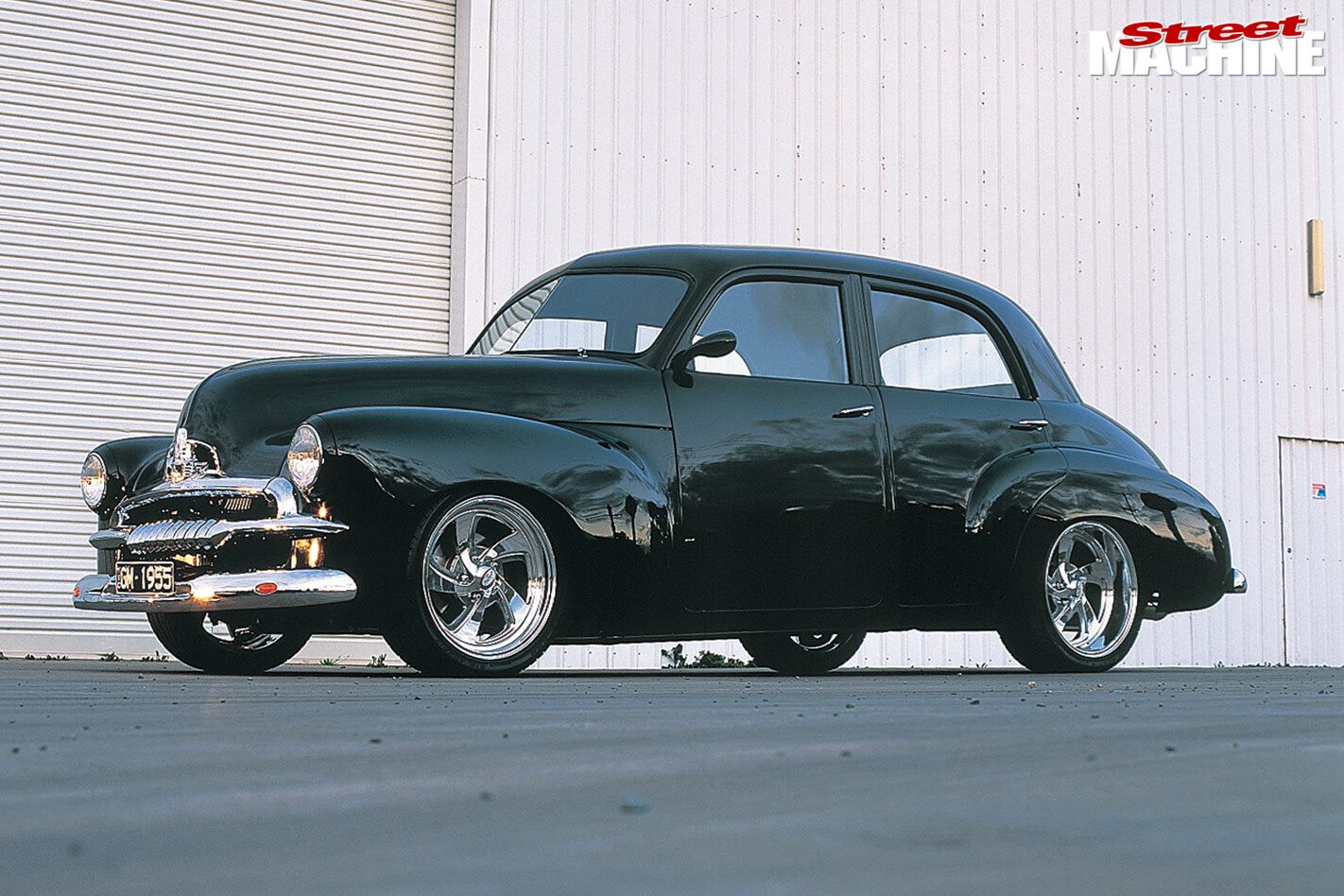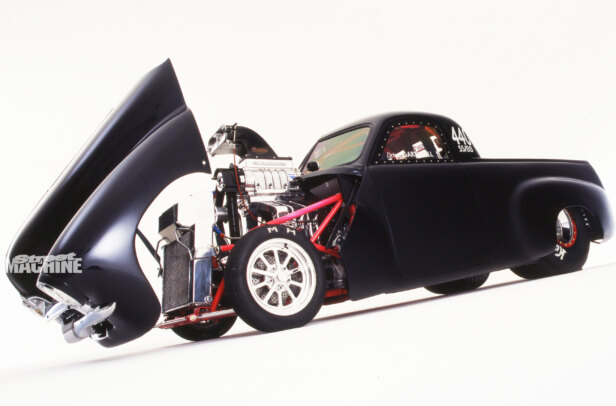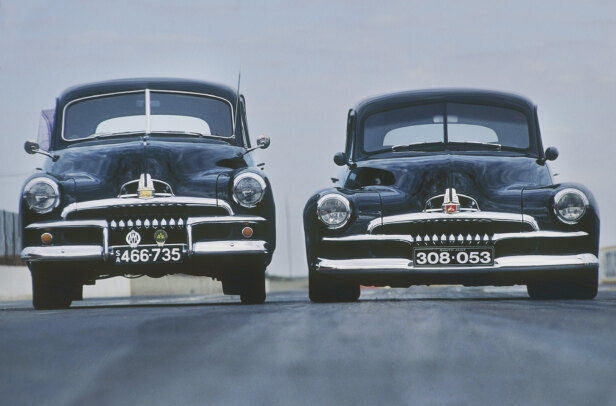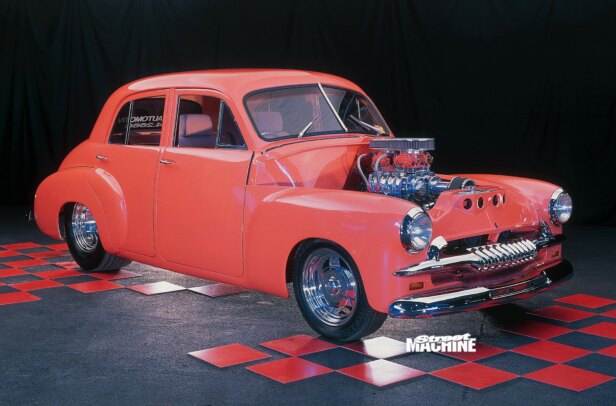THE SMILE on Glenn Madgwick’s face when someone tells him his car is ace is reward enough for dad Rick and the rest of the Madgwick clan. The trophies are recognition of the hard work that went into building the smick FJ Holden.
This article was first published in the June 2004 issue of Street Machine
“I’ve always loved cars and Glenn’s been bitten by the same bug,” Rick says. “As he was born on Australia Day we figured the car for him was the Holden, so we built him an FJ.”
That was when Glenn turned 18 and his mates were getting wheels. Even though a disability prevented him from driving, Rick figured there was no reason why Glenn couldn’t enjoy cars too.
“I got together with a few mates and we came up with a car we reckoned he’d like,“ Rick says.
Now 23 years old, Glenn was disabled from an early age and couldn’t work on the car, but he kept the VB flowing while his dad was under the bonnet, and he enjoys showing off the FJ at meets.
The FJ was never built to be a trophy winner — it was meant for Glenn’s enjoyment — but judges recognise its quality build and reward it.
“It’s important to us that it was a street machine. Some cars you see are just show cars and never get driven on the road. The person I’ve followed the most was Boyd Coddington,” Rick says. “He always built a car that was simple, but looked good. Even after years on the show circuit they still looked good. So we went for a classic and tried to build it simple but reliable. Simple is best in my mind.”
Rick found a neat ’55 FJ sedan in Melbourne. It had been mildly modified by its owner who was heading overseas and needed cash.
Rick stripped it to a bare shell and found — to his delight — that the body was in excellent condition.
He says: “Shane Rowe (Southern Rod & Custom) told us it was the best FJ body he’d seen when we dropped it off to his shop. It was so good we could paint it black. A body has to be good to do that.”
It’s hard to say whether or not this should be called a custom — some of the mods are hard to spot, they’re so beautifully worked into the FJ shape.
The billet wheels stand out. Then you notice the bumpers are shaved and tucked up against the body, the turn signals mounted into them.
Check the doors. There’s no quarter vent glass. Rick ripped out the vents, cut new glass and the whole lot slides with motors. The windshield centre bar is missing too — the glass is butt-joined.
Out back you’ll find Harley-Davidson tail lights in the rear panel, the licence plate set into the boot lid, and an aviation-style fuel filler in the right rear quarter.
And when you reckon you’ve got it sussed, Rick pops the hood — and it flips over on its side.
It took Shane some time to get it sorted but it works a treat, just like the old-time Seppo iron Rick remembers.
“I was fascinated by the way old Buicks went up to the side, and I reckoned the FJ bonnet should have been done that way,” Rick says of the neat touch.
Under the tilt hood lies a detailed engine bay with a cookin’ 350 small-block almost hidden under a flamed cover. The de-burred block was painted the same PPG black as the body before it was rebuilt by Shawn McCarroll.
It’s got a ‘baby’ cam, a 650cfm Holley four-barrel and Jet-Hot coated Block Hugger headers, but the rest is pretty stock “because we wanted to be able to drive it anywhere”.
An Aussie four-speed feeds the grunt to the nine-inch running highway gears.
The underbody is painted for stone protection over looks. “It’s nice and tidy but I wasn’t going to do it the same as the top of the car because of stones and oil and stuff,” says Rick.
A Castlemaine Rod Shop chassis kit links the original rails to the rear spring mounts. There’s a Lilow Auto Tech front crossmember with custom stainless wishbones and Alden coil-overs. A cut-down nine-inch rear hangs on up-rated leaf springs.
Leyland P76 discs, cross-drilled and slotted, and HX Holden calipers up front work with Fairlane discs and calipers at the rear to slow the black beauty.
Wheels are Boyd Coddington Rodders, 17×7 and 18×9, tyres are “black and round”.
Pop the boot lid and you’ll find a neatly-trimmed compartment with a wall that cuts the boot in half and hides the battery. Underneath there’s a custom-built drop tank for the fuel.
The interior’s plain, with grey leather trim and matching carpet, Commodore buckets, Vintage gauges in the original pod, and a Le Carra wheel on top of a stainless column.
One thing you won’t find is a thumpin’ sound system. “You listen to cars like this,” says Rick.
The project’s taken six years so far, and it’s been on the road for two. Rick plans to fit airbags when he can afford it: “They’re never really finished
are they?” he says.
Finished or not, Glenn and his family love the FJ project.
“Glenn gets tremendous fun out of the car,” Rick said. “He loves the people he meets at shows, and it’s enough for him if someone says it’s a nice car. It makes us happy to see him happy.”
RICK & GLENN MADGWICK
1955 FJ HOLDEN
Colour: PPG black
RUMBLIN’
Engine: 350ci Chev
Carb: 650cfm Holley
Manifold: “Yep”
Cam: “Baby”
Exhaust: Block Hugger headers, custom stainless system
Ignition: Electronic
ROCKIN’
Gearbox: Aussie four-speed
Diff: Narrowed nine-inch
Gears: “Highway”
RIDIN’
Front suspension: Lilow front-end, stainless wishbones, Alden coil-overs
Rear suspension: Leaf springs
Brakes: Discs all round
ROLLIN’
Wheels: Boyd Coddington Rodders, 18 x 7 (f), 18 x 9 (r)
Tyres: “Black and round”
RIPPIN’
Trim: Grey leather
Seats: Commodore bucket front seats, modified FJ bench rear
Wheel: Le Carra
Column: Stainless
Dials: Vintage
Sound: “No way!”




Comments